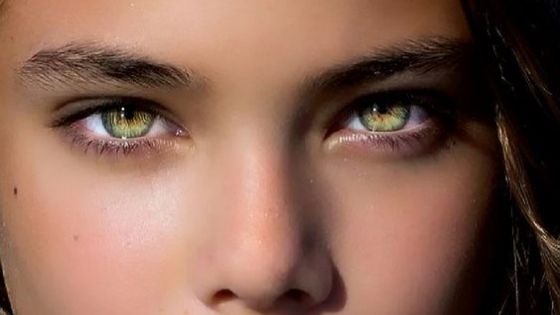Hunter Eyes, Are they attractive? Can you get them?

Hunter eyes are deep-set in the skull. They are also different in color from their prey's eyes. In addition, the distance between the inner corners of the hunter is longer than that of their prey counterparts.
Are they attractive? Yes, if they are on a human male. Facial attractiveness is indicative of the male's ability to survive and reproduce.
Proclaimed as the eyes of ancient times, some have described this type of eye as "cold." Yet, they hold an air of mystery and draw people in for their captivating stares.
These eyes usually look best when paired with gentler features such as soft-colored lips or oval-shaped faces. However, the shape of the face is not important. It's really about finding which eye shape matches up with your own.
Not everyone can pull off the hunter eyes. If you have a rounder face shape, you may want to keep away from this style of the eye or even avoid it together, depending on how much makeup you like wearing.
What are hunter eyes?
Hunter eyes are generally long and narrow, with round pupils. They are often dark in color, but they may be blue, greenish, or light brown.
The hunter's eyes can see at night because they have a greater concentration of rod cells than cones. There is also a reflective layer called tapetum lucidum, which bounces backlight to increase retinal illumination.
Can you get hunter eyes?
No. It's just a myth. No surgery or medical procedure on the market will give someone hunter eyes. There are just a few eye surgery procedures that can truly give you a "Hunter Eye" appearance, but none of them make your eyes appear more sunken.
Surgeries to get hunter eyes

You're not happy with your eyes. You've always wanted to have hunter's eyes, but you don't know how to get them.
It's hard to find information about how to get hunter eyes through surgery. Most of the information out there is outdated or just plain wrong.
We can help! Our guide will show you everything you need to know about getting hunter eyes through surgery.
Almond Eye Surgery
Almond eye surgery is a form of oculoplastic surgery that can make your eyes appear more sunken. Usually, this type of surgery lowers the eyelid after trauma, scarring, or other issues. It can also be used to give someone an almond shape instead of round eyes.
Popularized by Dr. Taban, the Almond Eye surgery is a rather risky surgery to go through. As with most surgeries, there is always the possibility of complications and infections.
Blepharoplasty
Blepharoplasty is the medical name for eye surgery. It's an operation that can change the shape of your eyelids and remove excess skin, and there are even cases where it will correct drooping upper eyelids.
Eye surgery can be beneficial for many people in various ways. For example, it's not uncommon for someone to need this type of surgery to heal from an injury after trauma to their eyes.
They may also need it if they have an infection or skin issue around their eyes. Sometimes, people use it as a preventative measure to stop drooping eyelids or create more space in-between their lashes to make them look longer.
Canthoplasty
Canthoplasty is a type of eye surgery that can shape the eyelid crease or create cosmetic changes in the appearance of the lids.
For example, it may involve removing excess skin from around the eyes, removing extra muscle folds, or correcting drooping upper eyelids.
Though this type of surgery has some risks, it's often used as a preventative measure for those worried about drooping eyelids or losing their lashes to constant rubbing.
While it makes a huge difference in your eye area, it does not improve the deepest point of your eye. However, it also plays into our Hunterseye shape.
A surgeon cuts a slit horizontally down into the eye laterals and reattachs the canthal tendon with the rim. The action will help raise the lateral canthus essentially vertically.
Ptosis repair surgery
Ptosis is the medical term for drooping eyelids. It requires upper blepharoplasty (eyelid surgery) to correct ptosis. If you have this, your lids will droop downward, and your lashes will touch your skin in some spots.
This can create a lack of space between your lashes and your eyebrows, leading to rubbing.
Ptosis repair is often done for cosmetic purposes because it drastically changes the appearance of your eyes. However, it's also beneficial if you have issues with drooping eyelids or loss of lashes from constant friction due to rubbing.
Orbital decompression
Orbital decompression surgery is an eye surgery that widens the eye socket to help with swelling or eye pressure.
This type of surgery is also known as reduction genioplasty, and it's typically done for those who have suffered from trauma, have tumors in their orbits, or have other medical conditions.
Surgery may be performed to prevent damage from the extra pressure on your eyes. It's also common as a preventative measure for those who are likely to suffer from this issue due to previous issues with their orbital sockets.
This surgery will not help you get closer to Hunter's eye if you have Grave's eye disease. It is accomplished by eliminating the bones and fat from the orbit itself. It relieves excessive pressure on the eye, which arises most mainly caused by Grave's Disease.
Eyelid Retraction surgery
Eyelid retraction surgery is a procedure that can treat people who have eyelids that droop far too low. The procedure is done by cutting the excess skin and tightening it to retract the eyelid.
It's also common for this type of eye surgery to be performed on those who have suffered from facial trauma, have tumors in their orbit, or have other medical conditions.
Eyelid retraction surgery is typically done for cosmetic purposes because it drastically changes the appearance of your eyes. However, it's also beneficial if you have issues with drooping eyelids or loss of lashes from constant friction due to rubbing.
These techniques are useful at helping achieve the Hunter Eye form. But of course, your eyes really have no deeper look.
Is it possible to make your eyes look like a hunter's eyes if you don't have them naturally?

Yes. It's all in the way you use your make-up. The key is to keep the eye shadow colors dark but minimal. Save lighter shades for highlighting other facial features and leave your eyes dark with maybe just one pop of lighter color.
Also, if you want to go as far as possible, they should lighten the inner corners of the eyes more than the rest of the eye. You can do this with a lighter eye shadow or even with some concealer.
By doing so, your eyes will look more open and reflective, which will give off an effect that looks like you have an extra light source in them. You can also get hunter eyes by:
Mewing
To get deeper in eyes, one must commit to mewing consistently. Mewing is just proper tongue and body positioning.
Mewing can help you to get hunter eyes because when you mew, your tongue fills in the eye socket and tightens up all of the face muscles. It's like doing an intense facial workout at home.
Mewing will help get rid of fine lines around your eyes and lift your cheekbones. It will give you that youthful appearance you want and help you achieve your goal of looking like a true hunter.
How to mewing?
- First, you want to push your tongue up to the roof of your mouth. Keep it there and tuck the tip of your tongue into your lower jaw.
- Then push your lips (to restrict mouth breathing) out as though you are pushing air through them, then pucker them inward towards one another.
- Maintain this position while breathing outwards so that your cheeks are expanding outwards. If you do this, it will give you that perfect hunter look.
Doing mewing just once a day for five minutes will give visible results in the long run. First, your face muscles become tighter, and fewer wrinkles form. Eventually, your cheekbones lift higher, and eye wrinkles disappear even if they weren't created by mewing.
What is the preying eye?
The hunter's eyes are located deeply into the skull while the predator's eyes are exposed. The roots behind the predator's eyes have large orbits. This is due to genetics, aging, or lack of support in the midface or maxillectomy area. The eye is circular and hollow.
What causes prey eyes?
The muscles of the orbital floor are no longer able to support the weight of the globe. This causes it to slowly sink into the face due to gravity when nothing is filling in that area. As a result, the eyes will also appear tired, heavy, and have dark circles under them.
Several causes are leading to a prey animal's eyes, including genetics and bad posture. Let’s discuss some further:
Scleral Show
The show of the scleral areas is when the sclera is visible on the lower lid. This can happen because of old age, trauma, or an endocrine disorder like an ophthalmologic defect.
Recessed Maxilla
When you have a recessed maxilla, you can fix it by using your tongue to push down on the inside of your mouth. This is called Mewing and helps people with a recessed maxilla grow their teeth forward and up. To do this, you need to maintain a proper tongue posture and swallow properly.
Mewing your tongue makes the mouth bigger. It also makes the sphenoid bone wider. Mewing can make your eyes look smaller too. No surgery will make the eye look like this picture, though.
Differences between hunter eyes vs. prey eyes
The key differences between a hunter's eyes vs. prey are the shape, size, and positioning.
A hunter eye is a deep-set in the skull, whereas prey eyes appear more open due to their transition from an orbital chasm.
A hunter eye has little or no show on the upper eyelid whereas, with prey eyes, they have a scleral show.
Positive canthal tilt occurs due to an excess of skin on the upper eyelid. The increase in the skin causes it to pull back, revealing more of the top of the sclera. This allows for better vision and enables us to see what's important right away.
A hunter eye is slightly smaller in size, whereas prey eyes appear bigger with a larger circular hole in the eye's middle.
The distance between a hunter's eye's inner and outer corners is longer than that of a prey animal due to their orbital chasm being deep set from the skull.
A prey eye is usually accompanied by a recessed maxilla which makes the eyes appear sunken, tired, and older. This may contribute to some of its effects on appearance as well.
Prey animals also generally have a thicker jawline making them appear more muscular and masculine.
Conclusion
The eyes are the windows to our soul, and if you have a hunter's gaze, then it could mean that your inner life is full of mystery. Hunter eyes may be dark in color, but they can also be blue, greenish, or light brown.
Medically reviewed and approved by Nataniel Josue M D.

